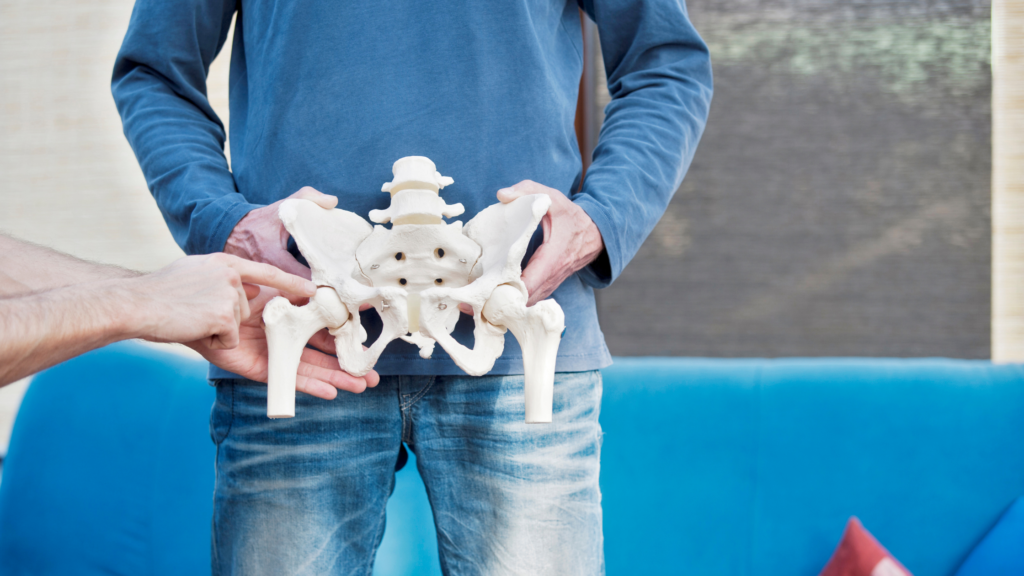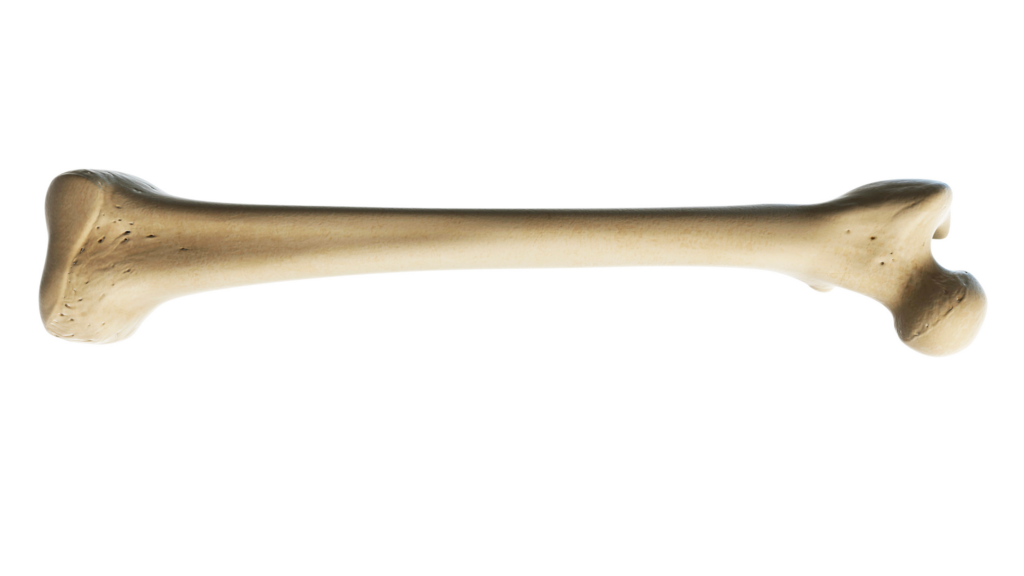The hip is known as a ball-and-socket joint because of its ability to move in multiple planes and rotate. This joint is a major weight-bearing joint, so degeneration caused by osteoarthritis is a common cause of hip pain.

Hip Anatomy: The Femoral Head & the Acetabulum
The hip joint is where the leg attaches to the pelvis. The thigh bone (femur) forms a ball at its top end, which fits perfectly into a hollow socket in the pelvis. The ball on the femur is called the femoral head, and the socket in the pelvis is called the acetabulum. The femoral head tapers down to become much more narrow in the femoral neck area. The femur widens again in the trochanter area, where muscle attachments are located to allow for hip motion.

Hip Anatomy: Articular Cartilage & Labrum
The femoral head and the acetabulum are covered by a layer of cartilage called articular cartilage. Articular cartilage has a smooth, firm, rubbery texture, allowing joint surfaces to glide efficiently. The labrum is a cartilage structure on the rim of the acetabulum, which makes “deeper” the socket part of the hip joint.
Hip Anatomy: Ligaments
The purpose of ligaments is to provide stability to a joint. Multiple ligaments combine to form a cylinder around the hip joint. These ligaments originate from the pelvis bones around the acetabulum, cross the hip joint, and attach to the femoral neck and trochanter region. These ligaments are powerful enough to ensure that the hip joint does not dislocate during normal use, and allow the hip to remain stable while it is moving or standing still.
Hip Injuries
Traumatic events such as athletic injuries or car crashes can injure the hip. In such circumstances, there is typically a discreet injury to one or more structures. A ligament could be wholly or partially torn, and the same is true for the labrum. There can also be localized injury to the articular cartilage on the femoral head or the acetabulum. The bones can also be injured. Fractures can occur in the trochanter area, the femoral neck, or the acetabulum. Blood supply to the femoral head can also be interrupted during injury, which damages the shape of the femoral head. There are specific orthopedic surgical procedures for these specific injuries. Another type of hip injury is much more gradual and occurs through the process of degeneration. This begins when there is a breakdown of the articular cartilage, which damages the smooth, gliding function of this tissue. Because cartilage tissue lacks an adequate blood supply, articular cartilage can never be restored to its original smooth surface. As cartilage continues to break down, it becomes thinner. With a thinner layer of cartilage between them, the joint’s bones now move closer together. Supporting joint ligament attachments are now also slightly closer together, which results in slack (laxity) of the supporting joint ligaments. Adding instability to a joint from ligament laxity results in more advanced cartilage breakdown. This process is painful and leads to swelling and altered joint function. Walking, standing, and even sleeping can become painfully difficult. This degenerative process is known as osteoarthritis.
Traditional Treatments for Hip Degeneration
The option is to surgically replace hips when the degeneration has advanced. Increasingly more people are becoming interested in intervening in some way before a hip joint reaches the stage where surgical replacement becomes the best option. As with every other medical condition, early intervention for hip osteoarthritis will result in the best outcome. Understanding the sequence of events that represents the process of hip osteoarthritis clarifies why specific non-surgical interventions are helpful. Activity modification helps minimize mechanical factors that may exceed a given joint’s tolerance. Weight loss is important to decrease the burden on weight bearing hip joints. Physical therapy and independent exercise programs help to maintain proper range of motion and muscular strength to support ideal hip joint motion. Non-steroidal anti-inflammatory drugs (NSAIDs) are available to address the inflammatory component of hip osteoarthritis. These medications help with the symptoms of pain, swelling, and stiffness but, they don’t change the degenerative process. NSAIDs can also cause organ damage with prolonged use.
Steroid medications can be injected into arthritic hip joints and provide the same anti-inflammatory benefits of relieving pain, swelling and stiffness. Steroids are more potent than NSAIDs, so the symptom relief is more prominent and lasts longer by comparison. Steroids, however, can cause or worsen many other health conditions and may eventually lead to the acceleration of articular cartilage degeneration with repeated injections. These factors limit the use of steroids for osteoarthritis.
Regenerative Treatments for Hip Arthritis
Regenerative Medicine is driven by an ever-increasing number of people who want to avoid joint replacement surgery for their hip osteoarthritis symptoms. Two specific treatments that are becoming progressively more popular are Bone Marrow Regenerative Cell Therapy and Platelet Rich Plasma (PRP) Therapy.
Bone Marrow Regenerative Cell Therapy for the Hip
Your bone marrow is a rich source of regenerative cells that have the potential to accelerate healing. Your bone marrow occupies the hollow center cavities of your bones and is literally a “factory” for the replacement of cells that circulate in your blood stream. Bone marrow regenerative cells recruit cell signaling recovery molecules (cytokines) and other healing cells to migrate into the injured area to assist with the recovery process. Bone marrow regenerative cells can be very helpful in restarting and accelerating the healing process of articular cartilage within a degenerative joint. Although the articular cartilage can never be restored to its original status, improvement in the “smoothness” of the articular cartilage can help slow the progression of osteoarthritis and help lessen pain. Regenerative cells can also stimulate improved integrity of the joint’s stabilizing ligaments. Addressing this laxity can also help slow the progression of osteoarthritis. Compared to purchasing “frozen regenerative cells in a vial”, using your own bone marrow regenerative cells ensures that no one else’s genetic material is injected into you; avoids the possibility of germ or other contamination introduced during processing; and guarantees that the cells have never been exposed to preservatives or subjected to a freeze/thaw cycle which potentially impacts their viability.
PRP (Platelet Rich Plasma) Therapy for the Hip Arthritis
Your “whole blood” is primarily liquid (plasma) containing solid particles like red cells, white cells, and the smaller platelets. During a PRP procedure, a syringe of your whole blood is obtained from your vein and then placed in a centrifuge to separate the plasma layer containing a high concentration of platelets. The desirable growth factors and other cytokines (cell signaling molecules) useful in healing are associated with platelets. After this platelet-rich layer of your own plasma has been isolated, it can be injected back into your body to target an area of tissue damage in muscles, tendons, ligaments, or joints.
The Regenerative Spine & Joint Center specializes in non-surgical treatment for hip osteoarthritis. Learn more at RegenerativeSpineAndJoint.com or call us today at (614) 999-9899 to find out if Bone Marrow Regenerative Cell Therapy or PRP is the right options for your hips.

